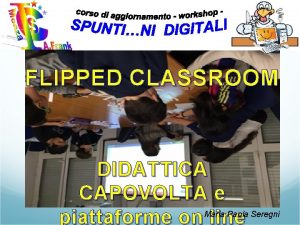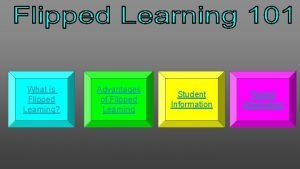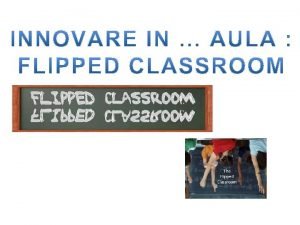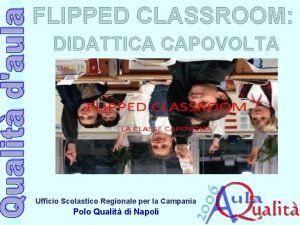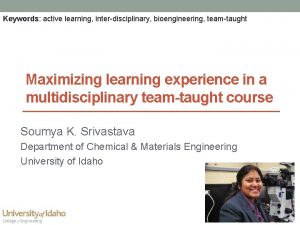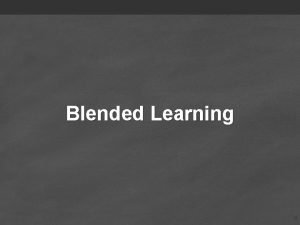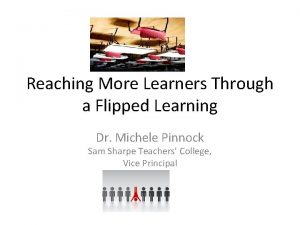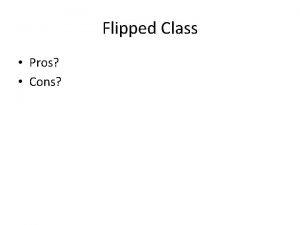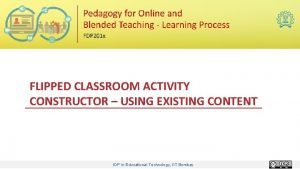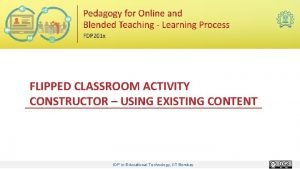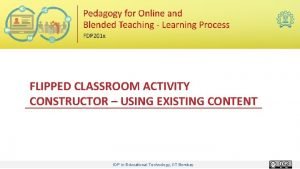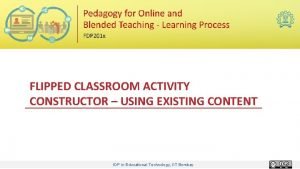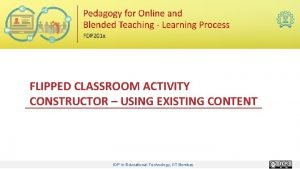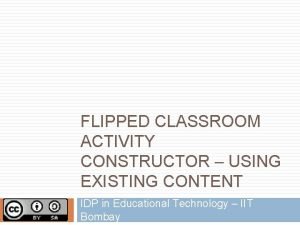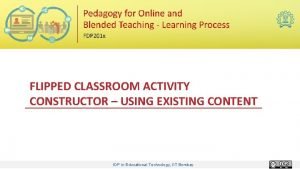FLIPPED CLASSROOM ACTIVITY CONSTRUCTOR USING EXISTING CONTENT IDP








- Slides: 8

FLIPPED CLASSROOM ACTIVITY CONSTRUCTOR – USING EXISTING CONTENT IDP in Educational Technology, IIT Bombay

About you Prof. Saurabh A. Ghogare Assistant Professor (Master in Computer Application), P. R. M. I. T&R. , Badnera. Topic: Basics of Finite State Machine IDP in Educational Technology, IIT Bombay 2

Prof. Saurabh A. Ghogare Topic: Construction of an FA/FSM Course : Theory of Computation Master in Computer Application MCA 1 st year PG students in MCA P. R. M. I. T. & R, Badnera(S. G. B. A. U ) Amravati IDP in Educational Technology, IIT Bombay 3

Out-of-class Activity Design -1 Learning Objective(s) of Out-of-Class Activity At the end of watching the videos student should be able to 1. To construct Finite Automata from an Regular Expression. 2. To convert NFA with Epsilon to NFA without Epsilon. Key Concept(s) to be covered 1. 2. 3. 4. Basics of Theory of computer Non Deterministic Finite Automata Regular Expression IDP in Educational Technology, IIT Bombay 4

Out-of-class Activity Design - 2 Main Video Source URL License of Video https: //www. youtube. com/watch? v=Qa 6 csfk. K 7_I You. Tube License CC-BY-SA (reuse allowed) Mapping Concept to Video Source VIDEO SEGMENT DURATION (in min) Basics of Theory of Computer V 1 -0. 00 -3. 35 Definition of NFA V 2 -3. 36 -5. 27 1. 91 Definition of DFA V 3 -5. 28 -7. 15 1. 87 Example of DFA & NFA V 4 -7. 16 -11. 04 3. 88 CONCEPT Regular Expression TOTAL DURATION 11. 04 Min IDP in Educational Technology, IIT Bombay 5

Out-of-class Activity Design - 3 Aligning Assessment with Learning Objective Expected duration (in min) Learning Objective Assessment Strategy Learner will be able to construct Finite Automata from an Regular Expression Q 1. Construct finite Automata for following Regular Expressions − 1. ‘a’ 2. (a+b) 3. (a+b)* 5 min Submit the solution at teachers desk before coming to class. Learner will be able to convert NFA with Epsilon to NFA without Epsilon. Q 2. Convert the following NFA with Epsilon to N FA without Epsilon. 5 min Submit the solution at teachers desk before coming to class. Additional Instructions (if any) Total activity duration 10 minutes IDP in Educational Technology, IIT Bombay 6

In-class Activity Design -1 Learning Objective(s) of In - Class Activity 1. 2. Students will be able to solve problems on conversion of Regular Expression into deterministic finite Automata using Thompson's Construction. Students will be able to solve problems on conversion of NFA with Epsilon to NFA without Epsilon Key Concept(s) to be covered 1. 2. 3. 4. Deterministic Finite Automata Regular Expression Thompson's Construction NFA with & without Epsilon IDP in Educational Technology, IIT Bombay 7

In-class Activity Design -2 Active Learning activity(ies) that you plan to do 1. Problem Solving 1. 2. 3. Explain the strategy by giving details of Students will be guided through 3 different types of problem solving exercises using Thompson's Construction inside the classroom They will then be required to solve 2 problems on their own Instructor will then summarize the pros and cons of using substitution method Justify why the above is an active learning strategy The students are involved in problem solving for some time during the class. During this time they go beyond listening to lecture or copying notes. They are active and are applying whatever they learnt. The instructor provides sufficient examples for students to follow and then explains the limitation of the method as a final summary. IDP in Educational Technology, IIT Bombay 8
